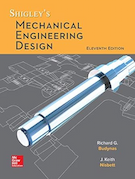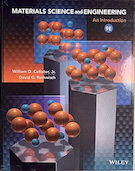Coefficient of Friction
Friction force develops between contacting surfaces of two bodies and acts to resist relative motion between the bodies. The friction force, F, is proportional to the normal force, N, and the coefficient of friction, μ:
| $$ F \lt \mu_s N $$ | static (no slip) |
| $$ F = \mu_s N $$ | static, impending slip |
| $$ F = \mu_k N $$ | sliding (slip between surfaces) |
where μs is the coefficient of static friction and μk is the coefficient of kinetic friction. The value of μs is generally higher than the value of μk for a given combination of materials.
Coefficients of friction between materials are best determined through testing. However, it is possible to find tables in the literature for friction coefficients between various materials. We have collected some of those tables here.
The table below is from Barrett, "Fastener Design Manual," NASA Reference Publication 1228, 1990:
| Materials | Static | Sliding | ||
|---|---|---|---|---|
| Dry | Greasy | Dry | Greasy | |
| Hard steel on hard steel | 0.78 | 0.11 (a) | 0.42 | 0.029 (k) |
| --- | 0.23 (b) | --- | 0.081 (e) | |
| --- | 0.15 (c) | --- | 0.080 (i) | |
| --- | 0.11 (d) | --- | 0.058 (j) | |
| --- | 0.0075 (p) | --- | 0.084 (d) | |
| --- | 0.0052 (h) | --- | 0.105 (k) | |
| --- | --- | --- | 0.096 (l) | |
| --- | --- | --- | 0.108 (m) | |
| --- | --- | --- | 0.12 (a) | |
| Mild steel on mild steel | 0.74 | --- | 0.57 | 0.09 (a) |
| --- | --- | --- | 0.19 (u) | |
| Hard steel on graphite | 0.21 | 0.09 (a) | --- | --- |
| Hard steel on babbitt (ASTM No. 1) | 0.70 | 0.23 (b) | 0.33 | 0.16 (b) |
| --- | 0.15 (c) | --- | 0.06 (c) | |
| --- | 0.08 (d) | --- | 0.11 (d) | |
| --- | 0.085 (e) | --- | --- | |
| Hard steel on babbitt (ASTM No. 8) | 0.42 | 0.17 (b) | 0.35 | 0.14 (b) |
| --- | 0.11 (c) | --- | 0.065 (c) | |
| --- | 0.09 (d) | --- | 0.07 (d) | |
| --- | 0.08 (e) | --- | 0.08 (h) | |
| Hard steel on babbitt (ASTM No. 10) | --- | 0.25 (b) | --- | 0.13 (b) |
| --- | 0.12 (c) | --- | 0.06 (c) | |
| --- | 0.10 (d) | --- | 0.055 (d) | |
| --- | 0.11 (e) | --- | --- | |
| Mild steel on cadmium silver | --- | --- | --- | 0.097 (f) |
| Mild steel on phosphor bronze | --- | --- | 0.34 | 0.173 (f) |
| Mild steel on copper lead | --- | --- | --- | 0.145 (f) |
| Mild steel on cast iron | --- | 0.183 (c) | 0.23 | 0.133 (f) |
| Mild steel on lead | 0.95 | 0.5 (f) | 0.95 | 0.3 (f) |
| Nickel on mild steel | --- | --- | 0.64 | 0.178 (x) |
| Aluminum on mild steel | 0.61 | --- | 0.47 | --- |
| Magnesium on mild steel | --- | --- | 0.42 | --- |
| Magnesium on magnesium | 0.6 | 0.08 (y) | --- | --- |
| Teflon on Teflon | 0.04 | --- | --- | 0.04 (f) |
| Teflon on steel | 0.04 | --- | --- | 0.04 (f) |
| Tungsten carbide on tungsten carbide | 0.2 | 0.12 (a) | --- | --- |
| Tungsten carbide on steel | 0.5 | 0.08 (a) | --- | --- |
| Tungsten carbide on copper | 0.35 | --- | --- | --- |
| Tungsten carbide on iron | 0.8 | --- | --- | --- |
| Bonded carbide on copper | 0.35 | --- | --- | --- |
| Bonded carbide on iron | 0.8 | --- | --- | --- |
| Cadmium on mild steel | --- | --- | 0.46 | --- |
| Copper on mild steel | 0.53 | --- | 0.36 | 0.18 (a) |
| Nickel on nickel | 1.10 | --- | 0.53 | 0.12 (w) |
| Brass on mild steel | 0.51 | --- | 0.44 | --- |
| Brass on cast iron | --- | --- | 0.30 | --- |
| Zinc on cast iron | 0.85 | --- | 0.21 | --- |
| Magnesium on cast iron | --- | --- | 0.25 | --- |
| Copper on cast iron | 1.05 | --- | 0.29 | --- |
| Tin on cast iron | --- | --- | 0.32 | --- |
| Lead on cast iron | --- | --- | 0.43 | --- |
| Aluminum on aluminum | 1.05 | --- | 1.4 | --- |
| Glass on glass | 0.94 | 0.01 (p) | 0.40 | 0.09 (a) |
| --- | 0.005 (q) | --- | 0.116 (v) | |
| Carbon on glass | --- | --- | 0.18 | --- |
| Garnet on mild steel | --- | --- | 0.39 | --- |
| Glass on nickel | 0.78 | --- | 0.56 | --- |
| Copper on glass | 0.68 | --- | 0.53 | --- |
| Cast iron on cast iron | 1.10 | --- | 0.15 | 0.070 (d) |
| --- | --- | --- | 0.064 (n) | |
| Bronze on cast iron | --- | --- | 0.22 | 0.77 (n) |
| Oak on oak (parallel to grain) | 0.62 | --- | 0.48 | 0.164 (r) |
| --- | --- | --- | 0.067 (s) | |
| Oak on oak (perpendicular) | 0.54 | --- | 0.32 | 0.072 (s) |
| Leather on oak (parallel) | 0.61 | --- | 0.52 | --- |
| Cast iron on oak | --- | --- | 0.49 | 0.075 (n) |
| Leather on cast iron | --- | --- | 0.56 | 0.36 (t) |
| --- | --- | --- | 0.13 (n) | |
| Laminated plastic on steel | --- | --- | 0.35 | 0.05 (f) |
| Fluted rubber bearing on steel | --- | --- | --- | 0.05 (t) |
| (a) Oleic acid; (b) Atlantic spindle oil (light mineral); (c) castor oil; (d) lard oil; (e) Atlantic spindle oil plus 2 percent oleic acid; (f) medium mineral oil; (g) medium mineral oil plus ½ percent oleic acid; (h) stearic acid; (i) grease (zinc oxide base); (j) graphite; (k) turbine oil plus 1 percent graphite; (l) turbine oil plus 1 percent stearic acid; (m) turbine oil (medium mineral); (n) olive oil; (p) palmitic acid; (q) ricinoleic acid; (r) dry soap; (s) lard; (t) water; (u) rape oil; (v) 3-in-1 oil; (w) octyl alcohol; (x) triolein; (y) 1 percent lauric acid in paraffin oil. | ||||
The table below is from MIL-HDBK-60, "Threaded Fasteners - Tightening to Proper Tension," 1990:
| Bolt/Nut Material (See Note) |
Lubricant | Coefficient of Friction, μ, ±20% |
|---|---|---|
| Steel | Graphite in Petrolatum or Oil | 0.07 |
| Steel | Molybdenum disulphide grease | 0.11 |
| Steel, Cadmium plated | None added | 0.12 |
| Steel, Zinc plated | None added | 0.17 |
| Steel | Machine oil | 0.15 |
| Steel/Bronze | None added | 0.15 |
| Corrosion resistant steel or nickel base alloys/silver plated materials | None added | 0.14 |
| Titanium/Steel | Graphite in petrolatum | 0.08 |
| Titanium | Molybdenum disulphide grease | 0.10 |



